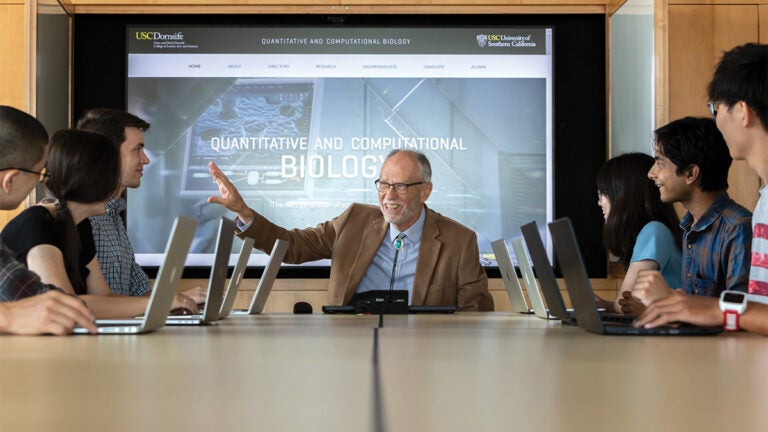
Michael Waterman meets with doctoral students. (Photo/Leah Lee)
An architect of the landmark Human Genome Project looks back
USC University Professor Emeritus Michael Waterman stood at the forefront of computational biology 40 years ago. The world is still catching up.
In the early 1980s, a quiet revolution sparked to life in Los Angeles.
Michael Waterman, then a recently hired professor of mathematics at the USC Dornsife College of Letters, Arts and Sciences, had published a new algorithm with colleague Temple Smith that determined similar regions of protein or DNA sequences. The Smith-Waterman algorithm would serve as a foundational piece of an emerging field of study, computational biology and bioinformatics.
Forty years later, Waterman is considered a father of quantitative and computational biology and his work forms the basis of numerous seminal studies, including the landmark Human Genome Project. The results of his work enabled researchers to analyze and identify long strings of genetic code, profoundly impacting molecular biology and medicine, cancer treatment and biofuel development and changing the way we view life on Earth. He will be recognized for his contributions to the field at the USC Computational Biology Symposium 2022 beginning Thursday.
But when he first proposed applying mathematical models to biological systems, peers didn’t know what to make of his work.
We submitted my first paper in this area to a journal and it was roundly rejected.
Michael Waterman, University Professor Emeritus
“We submitted my first paper in this area to a journal and it was roundly rejected, infuriating my co-author. Part of the rejection was that they felt the paper satisfied neither the biologists nor the mathematicians,” said Waterman, a University Professor Emeritus at USC. “Papers that attempt to address the spaces between subjects are usually worthless — except when they aren’t.
“I was convinced this was really going to be an area with important insights. I had no idea where we were going. But what started to get people interested was the Human Genome Project.”
Human Genome Project propels Waterman to international acclaim
The launch of the Human Genome Project — the international research effort to determine the DNA sequence of the entire human genome — in the early 1990s exploded our understanding of biology and foreshadowed the increasing importance of computing in the natural sciences. Waterman developed two algorithms essential to the project’s success. The Lander-Waterman algorithm accelerated physical mapping of genetic sequences, while the earlier Smith-Waterman algorithm serves as the foundation of computation genetics and remains the standard for gene and protein analysis.
The popularity and importance of the project thrust Waterman into the spotlight and earned him numerous accolades, including a Guggenheim Fellowship, the Canada Gairdner International Award, the U.S. National Academy of Sciences, the U.S. National Academy of Engineering, and the American Academy of Arts and Sciences and elections as a foreign member of the French Académie des Sciences and the Chinese Academy of Sciences.
“I was a scientist who didn’t publicize himself and didn’t give too many talks on my research, but the Human Genome Project transformed me,” he said. “I started giving talks to mathematicians about biology and talks to biologists about what math could do for them. All because there weren’t that many people doing this research. Of course, today it’s thousands, if not tens of thousands of people.”
When Waterman joined USC in 1982, he found a nascent genetics program and an administration open to developing an interdisciplinary research approach. His computational molecular biology group within the Department of Mathematics resulted in the creation of the world’s first PhD program in computational biology and bioinformatics. Nearly 40 years later, in 2021, USC Dornsife College announced the creation of the Department of Quantitative and Computation Biology. It hosts some of the top researchers in the field, including Geoffrey Fudenberg, Mark Chaisson, Adam MacLean, Jazlyn Mooney and Michael “Doc” Edge, and their success puts the future of the field in good stead, Waterman said.
Professor Waterman’s legacy at USC are many firsts.
Remo Rohs, USC Dornsife professor
of quantitative and computational biology
“Professor Waterman’s legacy at USC are many firsts — the first PhD program in computational biology and bioinformatics in the world and one of the first undergraduate majors in quantitative biology [QBIO] in the country,” said Rohs, professor of quantitative and computational biology and founding chair of the Department of Quantitative and Computational Biology. “I enjoy seeing that the QBIO undergraduate students still have a special place in professor WatermanÆs heart — I think they will be his proudest university achievement.”
“Now we have an academic unit so whatever the future of the field, it’s in their hands rather than being diffused,” Waterman added. “I like the group of young faculty that are in the department now — they are the future, and they have written some really excellent articles and books. It excites me to see them doing so well.”
Computational biology expert still looking for ‘the spaces between subjects’
This year marks two major milestones for Waterman. He rings in his 80th birthday and will be honored at the USC Computational Biology Symposium. Celebrating the 40th anniversary of quantitative biology and bioinformatics at USC, the symposium will feature Waterman and other luminaries in the field.
Waterman remains abreast of the latest developments in computational biology, regularly sitting in on departmental meetings and offering insights. He is especially interested in the analysis of molecular dynamics within cells, which — fittingly — marries biology and physics to allow scientists to more fully understand how cells operate.
“Biology is one of those subjects where the more you learn, the more complicated it gets. I’m not somebody who just drills down into pure math,” he said. “Pure math interests me less now than interacting with the world and its reflections.”



